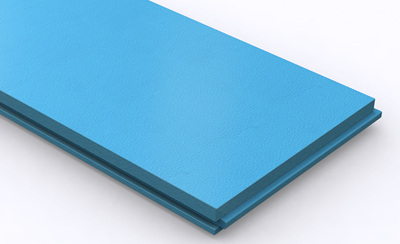General information
RAVATHERM XPS 300 ST plates are suitable for simple, quick, thermal bridge free thermal insulation of pitched roofs with reinforced concrete structures. Its main advantage is that similar to the inverted roof, RAVATHERM™ XPS 300 ST does not require any protection against rainwater or snow during implementation.
Other information
When thermal insulation is provided to reinforced concrete pitched roofs by installing XPS plates, the load bearing capacity of the roof structure can be fully utilized.
Since the high-strength thermal insulating plates are not compressed by the load usually experienced in case of pitched roofs, no rafter aimed to support the shell-cladding needs be integrated.
The manufacturing procedure of extruded polystyrene (XPS) plates produces a homogen-eous, closed-cell material structure having smooth surface skin (the so-called extrusion crust) which features various favorable characteristics, like:
- permanently high insulation co-efficient,
- water and frost resistance,
- high strength,
- high elastic rigidity,
- high resistance to damp diffusion
Such favourable properties make the XPS thermal insulation material suitable, beyond other applications, for the perfect implementation of pitched roofs with coved ceiling.
Technical
The closed-cell polystyrene foam plates must be must be laid down starting from the lower edge of the slanted slab in a way to make a continuous surface, in an offset binding based on the fastening plan, anchoring them to the reinforced concrete structure through the predrilled counter battens.
HIGH THICKNESS THERMAL INSULATION
In the case of thermal insulation with a large thickness (≥120 mm), it is recommended to install the thermal insulation in two layers. In the roof slope direction, impregnated fastening slats with 50/75 or 60/80 mm cross sections should be mounted to the reinforced concrete structure through the vapour barrier. Between the fastening slats, precisely tailored, 50 or 60 mm thick RAVATHERM™ XPS 300 ST thermal insulation should be fastenen pointwise by a solvent-free cold adhesive, or adhesive foam (e.g. INSTA-STIK). The bottom line must be mechanically mounted to the slab as well. In a way to make a continuous surface, the second layer of the RAVATHERM™ XPS 300 ST thermal insulation must be screwed to the pre-positioned fastening slats through the predrilled counter battens, in an offset binding, similarly to the wooden structure roofs.
WATERTIGHT underlay plating
The watertight underlay plating can be inserted beneath or above the thermal insulation layer. If the "beneath" option is chosen, it is wise to consider integration of bituminous sheets with rot-proof base stock. If the underlay plating is laid on the thermal insulation layer, it should be made of moisture permeating material.
AERATION
The branders' proposed thickness is at least 40 mm, in order to ensure efficient aeration and the strength needed for the safe fastening of the planking or slats fixed to carry the cover layer. However, the length and the angle of inclination of the roof can justify the use of 8 to 10 cm thick branders. Attention should be given to the dimensioning and the input/output flow of aeration should be designed carefully as to prevent overheating during the summer.

